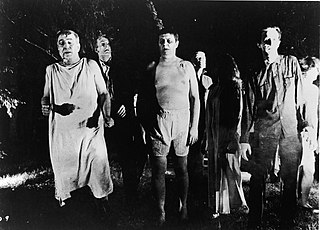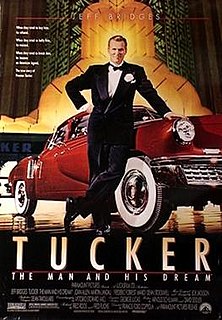Related Research Articles

Francis Ford Coppola is an American film director, producer, and screenwriter. He is considered one of the major figures of the New Hollywood filmmaking movement of the 1960s and 1970s and is the recipient of five Academy Awards, six Golden Globe Awards, two Palmes d'Or, and a British Academy Film Award.

Roger William Corman is an American film director, producer, and actor. He has been called "The Pope of Pop Cinema" and is known as a trailblazer in the world of independent film. Many of Corman's films are based on works that have an already-established critical reputation, such as his cycle of low-budget cult films adapted from the tales of Edgar Allan Poe.

A B movie or B film is a low-budget commercial motion picture. In its original usage, during the Golden Age of Hollywood, the term more precisely identified films intended for distribution as the less-publicized bottom half of a double feature. However, the U.S. production of films intended as second features largely ceased by the end of the 1950s. With the emergence of commercial television at that time, film studio B movie production departments changed into television film production divisions. They created much of the same type of content in low budget films and series. The term B movie continues to be used in its broader sense to this day. In its post-Golden Age usage, there is ambiguity on both sides of the definition: on the one hand, the primary interest of many inexpensive exploitation films is prurient; on the other, many B movies display a high degree of craft and aesthetic ingenuity.
Direct-to-video or straight-to-video refers to the release of a film, TV series, short or special to the public immediately on home video formats rather than a theatrical release. This distribution strategy was prevalent before streaming platforms came to dominate the TV and movie distribution markets.

An independent film, independent movie, indie film, or indie movie is a feature film or short film that is produced outside the major film studio system, in addition to being produced and distributed by independent entertainment companies. Independent films are sometimes distinguishable by their content and style and the way in which the filmmakers' personal artistic vision is realized. Usually, but not always, independent films are made with considerably lower budgets than major studio films. In fact, it is not unusual for well-known actors who are cast in independent features to take substantial pay cuts if they truly believe in the message of the film, or if they are returning a favor to a filmmaker, or simply because they want to work with a particular director that they admire. There are many examples of the latter, such as John Travolta and Bruce Willis taking less pay to work with Quentin Tarantino on Pulp Fiction.

Robert Coppola Schwartzman is an American filmmaker, director, screenwriter, actor and musician. Schwartzman is best known for directing Dreamland, The Unicorn, and The Argument, acting in his cousin Sofia Coppola's projects Lick the Star and The Virgin Suicides, as well as starring in The Princess Diaries and as the lead vocalist of the rock/pop band Rooney.
Filmmaking is the process by which a motion picture is produced. Filmmaking involves a number of complex and discrete stages, starting with an initial story, idea, or commission. It then continues through screenwriting, casting, pre-production, shooting, sound recording, post-production, and screening the finished product before an audience that may result in a film release and an exhibition. Filmmaking occurs in a variety of economic, social, and political contexts around the world. It uses a variety of technologies and cinematic techniques.
A film school is an educational institution dedicated to teaching aspects of filmmaking, including such subjects as film production, film theory, digital media production, and screenwriting. Film history courses and hands-on technical training are usually incorporated into most film school curricula. Technical training may include instruction in the use and operation of cameras, lighting equipment, film or video editing equipment and software, and other relevant equipment. Film schools may also include courses and training in such subjects as television production, broadcasting, audio engineering, and animation.

Tucker: The Man and His Dream is a 1988 American biographical comedy-drama film directed by Francis Ford Coppola and starring Jeff Bridges. The film recounts the story of Preston Tucker and his attempt to produce and market the 1948 Tucker Sedan, which was met with scandal between the "Big Three automobile manufacturers" and accusations of stock fraud from the U.S. Securities and Exchange Commission. Joan Allen, Martin Landau, Elias Koteas, Frederic Forrest and Christian Slater appear in supporting roles. Landau won the Golden Globe Award for Best Supporting Actor and was nominated for the Academy Award in the same category.

A low-budget film or low-budget movie is a motion picture shot with little to no funding from a major film studio or private investor. Many independent films are made on low budgets, but films made on the mainstream circuit with inexperienced or unknown filmmakers can also have low budgets. Many young or first time filmmakers shoot low-budget films to prove their talent before doing bigger productions. Most low-budget films that do not gain some form of attention or acclaim are never released in theatres and are often sent straight to retail because of their lack of marketability, look, narrative story, or premise. There is no precise number to define a low budget production, and it is relative to both genre and country. What might be a low-budget film in one country may be a big budget in another. Modern-day young filmmakers rely on film festivals for pre-promotion. They use this to gain acclaim and attention for their films, which often leads to a limited release in theatres. Films that acquire a cult following may be given a wide release. Low-budget films can be either professional productions or amateur. They are either shot using professional- or consumer-grade equipment.
Film finance is an aspect of film production that occurs during the development stage prior to pre-production, and is concerned with determining the potential value of a proposed film.
Guerrilla filmmaking refers to a form of independent filmmaking characterized by ultra-low micro budgets, skeleton crews, and limited props using whatever resources, locations and equipment is available. Often scenes are shot quickly in real locations without any warning, and without obtaining filming permits.

The Guerilla Filmmakers Handbook is a bestselling textbook on low-budget and independent film production written by Chris Jones and Genevieve Jolliffe. Currently in its third edition, it consists primarily of interviews with filmmakers and case studies in filmmaking. The Handbook has become widely respected in the UK as a comprehensive filmmaking guide.

Z movies are low-budget films that have qualities lower than B movies.

Cinematic exhibition of the B movie, defined as a relatively low-cost genre film, has declined substantially from the early 1980s to the present. Spurred by the historic success of several big-budget movies with B-style themes beginning in the mid-1970s, the major Hollywood studios moved progressively into the production of A-grade films in genres that had long been low-budget territory. With the majors also adopting exploitation-derived methods of booking and marketing, B movies began to be squeezed out of the commercial arena. The advent of digital cinema in the new millennium appeared to open up new opportunities for the distribution of inexpensive genre movies.
A mockbuster is a film created to exploit the publicity of another major motion picture with a similar title or subject. Mockbusters are often made with a low budget and quick production to maximize profits. Unlike films produced to capitalize on the popularity of a recent release by adopting similar genre or storytelling elements, mockbusters are generally produced concurrently with upcoming films and released direct-to-video at the same time the real film is released. A mockbuster may be similar enough in title and/or packaging that consumers confuse it with the actual film it mimics, but their producers maintain that they are simply offering additional products for consumers who want to watch more films in the same subgenres.
A film studio is a major entertainment company or motion picture company that has its own privately owned studio facility or facilities that are used to make films, which is handled by the production company. Most firms in the entertainment industry have never owned their own studios, but have rented space from other companies.
Blumhouse Productions is an American film and television production company founded in 2000 by Jason Blum. It is known mainly for producing horror films, such as Paranormal Activity, Insidious, The Purge, Split, Get Out, Happy Death Day, Halloween, Us, and The Invisible Man. It has also produced drama films, such as Whiplash and BlacKkKlansman, which both earned nominations for the Academy Award for Best Picture; Get Out and BlacKkKlansman won Academy Awards for Best Original Screenplay and Best Adapted Screenplay, respectively. It also produced The Normal Heart, which won the 2014 Primetime Emmy Award for Outstanding Television Movie. It has worked with directors such as Leigh Whannell, Jordan Peele, Christopher Landon, James Wan, Mike Flanagan, James DeMonaco, Damien Chazelle, M. Night Shyamalan and Spike Lee.

Indie Rights, Inc. is an American distributor of independent films, based in Los Angeles, California. Indie Rights is a subsidiary of Nelson Madison Films and was incorporated in 2007 to act as distributor for other independent filmmakers. The corporation began as a private MySpace group where the makers of independent films could get information about the changing face of film distribution; founders Linda Nelson and Michael Madison created Indie Rights so that distribution contracts could be signed by a legal entity. The corporation distributes films largely through video on demand services, though more recently it has overseen such theatrical releases as We Are Kings and Fray, both in 2014.

Dallas Sonnier is an American film producer, publisher, and entrepreneur. He is best known as the founder of Cinestate and, from 2018 to 2020, the publisher of Fangoria magazine. He has producing credits on the films Bone Tomahawk (2015), Brawl in Cell Block 99 (2017), The Standoff at Sparrow Creek (2018), and Dragged Across Concrete (2019), among others. In 2018, he purchased the rights to Fangoria and relaunched the defunct magazine as a print-only publication; he additionally expanded the Fangoria brand to encompass a publishing and film production company.
References
- ↑ Microfilmmaker Magazine, Mission
- ↑ Microfilmmaker Magazine, Mission
- ↑ Disney downsizing a downer for indies. Sharon Stewart. Daily Variety: 10/07/2009
- ↑ Francis Ford Coppola, interview in Hearts of Darkness: A Filmmaker’s Apocalypse (1991)
- ↑ "Stacey Parks, Founder, Film Specific". www.filmspecific.com. Retrieved 16 August 2016.
- ↑ The haunted history of ‘Paranormal Activity.’ John Horn. Los Angeles Times: 9/20/2009
- ↑ Hollywood studios in midst of their own horror show. John Horn, Ben Fritz, Rachel Abramowitz. Los Angeles Times: 10/06/2009
- ↑ The movie magic is gone. Neal Gabler. Los Angeles Times: 2/25/2009